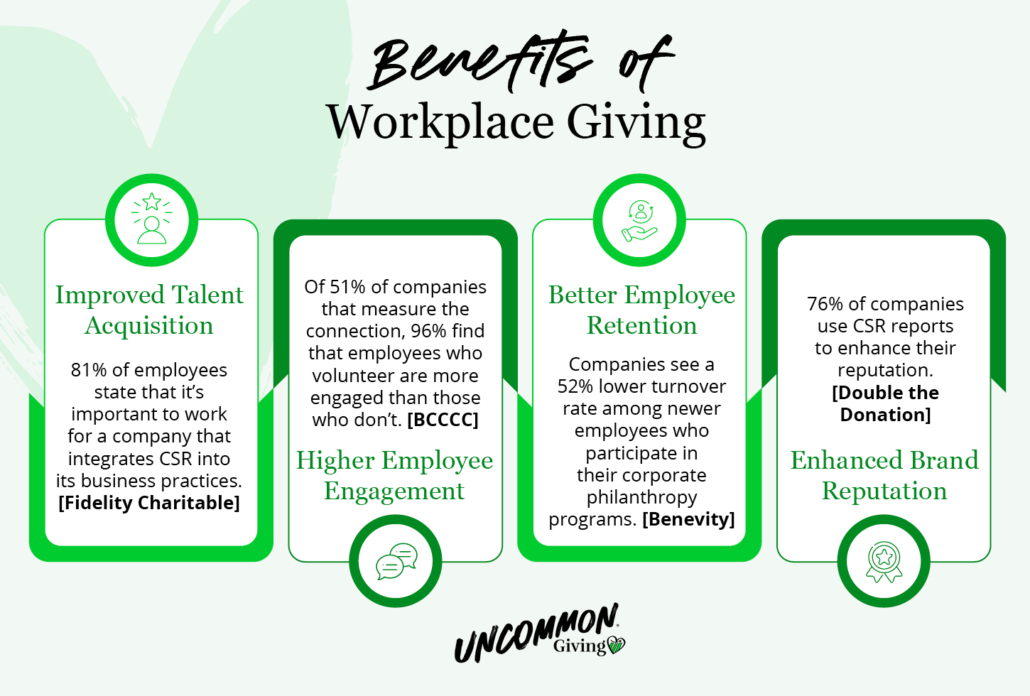Answering 4 FAQs About Starting a Workplace Giving Program
You’ve likely heard about workplace giving and its potential to transform your company’s reputation, culture, and employee engagement for the better. By becoming an industry leader in corporate social responsibility (CSR), you can stand out from competitors and enact lasting change in your community.
However, launching a successful workplace giving program requires thoughtful planning and implementation. After all, you need to ensure that your employees are aware of the opportunities you create and consider how you’ll maintain transparency when reporting your social impact.
If your company is looking to join the ranks of other mission-driven businesses by starting a workplace giving program, explore these frequently asked questions to establish a strong foundation for success.
1. Why should companies start a workplace giving program?
Your business already has many priorities to focus on, from managing customer relationships to meeting project deadlines. While implementing a workplace giving program requires some initial investment, the benefits you reap will be well worth the effort. According to Uncommon Giving’s workplace giving guide, many companies experience:

- Improved talent acquisition. 81% of employees believe that it’s important to work for a company that integrates CSR into its business practices. Providing workplace giving opportunities can help your business catch the attention of talented job seekers who want to make a difference in the world.
- Higher employee engagement. Of the 51% of companies that measure the connection, 96% find that employees who volunteer are more engaged than those who don’t. A workplace giving program makes it easy for your employees to find a sense of purpose, belonging, and connection in their day-to-day responsibilities.
- Better employee retention. Companies see a 52% lower turnover rate among newer employees who participate in corporate philanthropy programs. When employees can make an impact through your business, they’re more likely to feel fulfilled in their roles. Plus, social opportunities such as team volunteering events allow them to develop closer friendships with their colleagues.
- Enhanced brand reputation. 76% of companies use CSR reports to boost their reputation. Beyond producing stellar products and services, many consumers expect your business to act as a force for social good within its community. A workplace giving program demonstrates that you’re committed to more than just earning high profits.
Any business, regardless of its size or resources, can set up a workplace giving program tailored to its needs, goals, and employee preferences. You don’t need to go all out to begin tapping into the benefits of your improved CSR—start with a low-lift, reasonable approach and expand gradually from there.
2. What are common types of workplace giving?
Depending on your company’s priorities and resources, there are several types of workplace giving that you can include in your program. The most common ones are:
- Matching gifts. Your company can match the donations that employees make to nonprofits, typically at a 1:1 ratio. Through matching gifts, employees have the opportunity to double or even triple the impact of their donations.
- Volunteer grants. When an employee volunteers regularly with a nonprofit, they can submit a volunteer grant request to your company after contributing a minimum number of hours. Then, your company will donate to that organization, with the amount depending on the hours served.
- Corporate volunteering. Your company can encourage employees to provide pro bono skills and services to nonprofits by hosting team-wide volunteering events throughout the year. Additionally, you can promote upcoming volunteer opportunities with local nonprofits through your internal channels.
- Payroll deductions. Some employees are looking for an easy and consistent way to support the charitable causes they care about. Through payroll deductions, they can automatically deduct a portion of their paycheck to donate to nonprofits.
Don’t be afraid to get creative with your workplace giving campaigns to find the ones that appeal most to your employees. For example, Double the Donation shares several engaging ideas to get you inspired, such as auctions, nonprofit sponsorships, and back-to-school drives. To manage it all, simply look for a workplace giving platform that can handle a variety of initiatives all in one place.
3. What should you look for in workplace giving software?
As with any nonprofit software, when building out your CSR technology toolkit, it’s important to first conduct thorough research into your options. Doing so ensures that you find a platform that fits your specific budget and needs.
The top workplace giving solutions should:
- Be user-friendly and come with extensive support resources.
- Allow you to make grants to nonprofits.
- Automate the matching gift process.
- Streamline volunteer grant requests and processing.
- Facilitate planning and hosting volunteering events.
- Integrate with your payroll system to facilitate automatic deductions.
- Provide real-time reporting dashboards on social impact and employee participation.
Explore workplace giving platform product pages and read their reviews to compile a list of top choices for your business. You can even reach out to connections at other companies in your industry to ask if they have any recommendations. Then, request demos to get a firsthand understanding of how each platform works and make your final decision.
4. How can you encourage participation in workplace giving?
Ultimately, the success of your workplace giving program depends on the participation of your employees. Use the following tips to maximize engagement and make it easy for employees to get involved:
- Promote your workplace giving program. Take the time to inform employees about all the workplace giving opportunities they can participate in. When you first launch your program, send out a company-wide announcement, incorporate it into your onboarding materials, and organize Q&A sessions for employees who want to learn more. Then, share updates through internal channels and social media.
- Set broader criteria for participation. Some companies only allow full-time employees to take part in workplace giving. To power more impact, however, you can consider extending participation to their spouses and part-time employees. Additionally, you could set a low minimum gift match amount or volunteer hour requirement to encourage more people to engage with matching gifts or volunteer grants.
- Recognize employees for their workplace giving participation. Recognition is a highly effective way to reinforce your company’s values and make employees feel acknowledged for their efforts. Express your appreciation when employees join your workplace giving initiatives by sending personalized eCards, shouting them out on social media, or hosting a celebration event for everyone to enjoy.
With your workplace giving software, you should be able to generate real-time reports on impact, employee participation, fundraising progress, and volunteer hours contributed. As you test out new strategies to encourage engagement in your workplace giving program, use this data to evaluate your success.
Launching a workplace giving program is a pivotal step toward improving your CSR and establishing your company as a powerful champion of social good within your community. To design opportunities and criteria that align with your purpose and employee values, send out regular surveys to collect their direct feedback. Use their responses to identify ways you can improve your program and amplify your impact in the long run.
